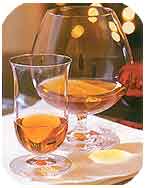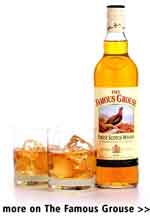|
WHISK(e)Y
There are four major whisk(e)y producing countries each of whom produce distinct whisk(e)ys. Whisk(e)y itself is a vast topic and each of these types of whisky have great and long historys. This feature attepts to highlight some of their individual histories, distilling process and characteristics. We encourage you to read some of the many detailed books on the subject and experiment with whisk(e)y and learn to taste and appreciate their differences.
AMERICAN WHISKEY
BOURBON According to Federal regulations, for an American whiskey to be labeled as bourbon it must be made from a mash containing between 51% and 79% corn. If the corn content is higher, the product must be designated as corn  whiskey. Bourbon is a straight whiskey and, according to the law, must be distilled at 160 proof (80% alcohol) or less and must be aged a minimum of two years in new charred oak barrels. As a practical matter, though, most bourbon is aged at least four years and often longer. Since it is a straight whiskey, no blending is permitted and there are no additives, with the exception of water to reduce the proof. whiskey. Bourbon is a straight whiskey and, according to the law, must be distilled at 160 proof (80% alcohol) or less and must be aged a minimum of two years in new charred oak barrels. As a practical matter, though, most bourbon is aged at least four years and often longer. Since it is a straight whiskey, no blending is permitted and there are no additives, with the exception of water to reduce the proof.
Most bourbons are marketed as 80-proof products, but some, particularly the newer boutique, small-batch, single barrel and barrel proof products are much higher in alcohol content.
By law, bourbon can be distilled anywhere in the U.S., but the vast majority of it is produced in Kentucky, where it must be distilled and warehoused for at least one year in order to carry the "Kentucky Bourbon" designation on the label.
Popular AMERICAN WHISKEY RECIPES
- Manhattan
- Old Fashioned
- Mint Julep
- Bourbon Daisy
|
TENNESSEE WHISKEY Although its grain content need only be comprised of at least 51% of any grain, corn is usually used in making Tennessee whiskey. It is made in a similar manner to sour mash bourbon but Tennessee whiskey also includes an extra step in its
production process -- the distilled spirit is filtered through maple charcoal in large, wooden vats before aging in order to remove impurities.
AMERICAN BLENDED WHISKEY American blended whiskey is comprised of brands which have been created by carefully blending straight whiskies with grain spirits. This category once accounted for almost half of all domestically-produced whiskey consumed in the US .
By law, a blended whiskey must contain a minimum of 20% straight whiskey. A premium brand may contain as many as 75 different straight whiskies and grain neutral spirits. The purpose of blending is to create a balanced, light-bodied whiskey, with a richness in taste and an individual character of its own. Balance is achieved because the blending art assembles a variety of elements into a unique and distinctive product. Another hallmark of blended whiskies is their consistency of taste.
Popular IRISH WHISKEY RECIPES
- Shamrock # 1
- Paddy Cocktail
- Irish Coffee
|
IRISH WHISKEY The distillation of Irish Whiskey has a long history, no one knows for sure when it first began. Some sources place it as early as the 6th Century when Irish monks brought the distillation process back from the Middle East . We may never know for sure but can be thankful it was started sometime in the distance past, enabling many hundreds of years of experience and perfection to bring us to the stage we are at today. Certainly the distillation process in Ireland is many hundreds of years old.
In Gaelic the drink became knowh as "Uisce Beatha" which means "water of life." The Normans called it "fuisce" and eventually it evolved into "whiskey." What needs to come together? Barley, clear waters, and peat for the fires to toast the barley are the key ingredients. They are certainly all found in Ireland !
Apart from the spelling Irish whisk(e)y differs from Scotch Whisky in that normally Irish is distilled three times (but not always) verses two for most scotch. The malting process also differs between Irish & Scoth, as Irish Whiskey uses sprouted barley dried in a closed kiln that is then mixed with unmalted barley before being ground into a grist. This accounts for the smoothness of Irish whiskey and the "non-peaty" taste compared to Scotch.
Popular SCOTISH WHISKY RECIPES
- Rob Roy
- Rusty Nail
- Affinity # 1 Cocktail
|
SCOTISH WHISKY Scotland is undoubtedly one of the world's classic whisky-producing regions. It is blessed with a combination of natural resources and climate that has proven ideal for making whisky.
As Scotland 's chief export, whisky is inextricably bound to the fabric of the nation's culture and economy.
SINGLE MALTS Making malt whisky is an expensive, labor-intensive process that involves several general steps. The grain used in the mash for making single malt whisky is specially selected barley, which has been soaked in water for sprouting. The sprouted barley is then dried in kilns fired by peat and coal. This kilning process imparts a distinctive smoky character to the spirit. As is the case with other whiskies, the malted barley is then mixed with warm water to produce a mash which is then fermented with the addition of yeast and distilled. The newly distilled spirit (about 70% alcohol) is then pumped into casks. At this point it is designated as "plain British spirits," but after three years in the barrel, it can be called whisky.
Produced by more than 100 Scotch distilleries, each single malt has a style and flavor all its own. It is also important to note that each single malt is the product of a single distillery and comes from a single batch of whisky.
SCOTCH BLENDED WHISKY  More than 90% of the Scotch consumption in this country can be attributed to brands of blended whisky. The object of blending has always been to "soften," in a sense, the harsher characteristics of the individual malt whiskies with the intention of producing a whisky with widespread appeal. More than 90% of the Scotch consumption in this country can be attributed to brands of blended whisky. The object of blending has always been to "soften," in a sense, the harsher characteristics of the individual malt whiskies with the intention of producing a whisky with widespread appeal.
As the word implies, blends are the result of mixing different whiskies together, including both single malts and grain whiskies. Located mainly in the Lowlands , the 14 Scottish grain distilleries produce grain spirits (which are in fact whiskies, not, as is sometimes misinterpreted, neutral grain spirits), made primarily from corn (maize). They are distilled in tall, column stills, a method that is faster and less expensive than the pot still.
Numerous variables determine the ultimate character of a blended Scotch, such as the quality of the barley, the amount of peat used, the length of the second distillation and decisions about when each particular cask is ready to be added to the blend.
This last step is an art as well as a science. Each Scotch house has its own closely guarded blend. Usually there are 20 to 25 different single malt whiskies used in a blend, and although the exact proportions are not known, anywhere from 20% to 50% malt whisky will be used in a blend, with the rest being grain whisky.
Popular CANADIAN WHISKY RECIPES
- Canadian Daisy
- Cablegram
- Manhattan Canadian
|
CANADIAN WHISKY Canadian Whisky is made primarily from corn or wheat, with a supplement of rye, barley, or barley malt.
There are no Canadian government requirements when it comes to the percentages of grains used in the mash bill. Unlike Bourbons, they are aged, primarily in used oak barrels. The minimum age for Canadian Whisky is three years, with most brands being aged four to six years. Virtually all Canadian whiskies are blended from different grain whiskies of different ages.
Early Canadian whiskies were made primarily from rye. In time most Canadian distillers turned to corn, wheat, and other grains, but Canadians continue to refer to their whisky as " Rye " even though the mash bill for most Canadian Whisky is now predominantly a mix of corn, wheat, and barley, with only a modest proportion of rye for flavor, which results in a lighter-bodied spirit.
This lighter -bodied spirit makes Canadian Whisky the perfect whisky to use as base in the many drink recipes that call for a whisky.
|
